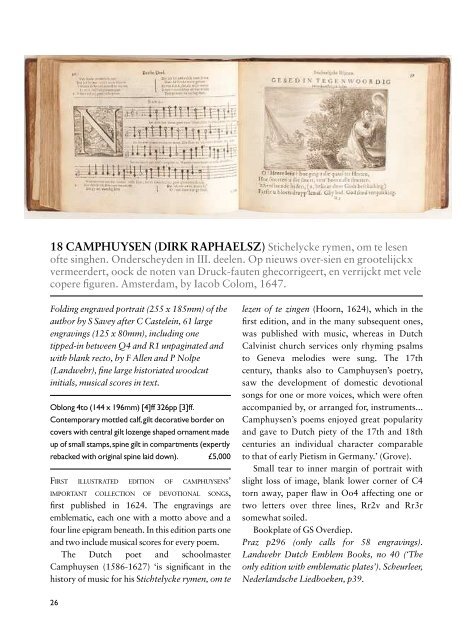CONTINENTAL BOOKS CATALOGUE 1448 - Maggs Bros. Ltd.
CONTINENTAL BOOKS CATALOGUE 1448 - Maggs Bros. Ltd.
CONTINENTAL BOOKS CATALOGUE 1448 - Maggs Bros. Ltd.
You also want an ePaper? Increase the reach of your titles
YUMPU automatically turns print PDFs into web optimized ePapers that Google loves.
18 CAMphUYSEN (DIRK RAphAELSz) Stichelycke rymen, om te lesen<br />
ofte singhen. Onderscheyden in III. deelen. Op nieuws over-sien en grootelijckx<br />
vermeerdert, oock de noten van Druck-fauten ghecorrigeert, en verrijckt met vele<br />
copere figuren. Amsterdam, by Iacob Colom, 1647.<br />
Folding engraved portrait (255 x 185mm) of the<br />
author by S Savey after C Castelein, 61 large<br />
engravings (125 x 80mm), including one<br />
tipped-in between Q4 and R1 unpaginated and<br />
with blank recto, by F Allen and P Nolpe<br />
(Landwehr), fine large historiated woodcut<br />
initials, musical scores in text.<br />
Oblong 4to (144 x 196mm) [4]ff 326pp [3]ff.<br />
Contemporary mottled calf, gilt decorative border on<br />
covers with central gilt lozenge shaped ornament made<br />
up of small stamps, spine gilt in compartments (expertly<br />
rebacked with original spine laid down). £5,000<br />
First illustrAted edition oF cAmphuysens’<br />
importAnt collection oF devotionAl songs,<br />
first published in 1624. The engravings are<br />
emblematic, each one with a motto above and a<br />
four line epigram beneath. In this edition parts one<br />
and two include musical scores for every poem.<br />
The Dutch poet and schoolmaster<br />
Camphuysen (1586-1627) ‘is significant in the<br />
history of music for his Stichtelycke rymen, om te<br />
lezen of te zingen (Hoorn, 1624), which in the<br />
first edition, and in the many subsequent ones,<br />
was published with music, whereas in Dutch<br />
Calvinist church services only rhyming psalms<br />
to Geneva melodies were sung. The 17th<br />
century, thanks also to Camphuysen’s poetry,<br />
saw the development of domestic devotional<br />
songs for one or more voices, which were often<br />
accompanied by, or arranged for, instruments...<br />
Camphuysen’s poems enjoyed great popularity<br />
and gave to Dutch piety of the 17th and 18th<br />
centuries an individual character comparable<br />
to that of early Pietism in Germany.’ (Grove).<br />
Small tear to inner margin of portrait with<br />
slight loss of image, blank lower corner of C4<br />
torn away, paper flaw in Oo4 affecting one or<br />
two letters over three lines, Rr2v and Rr3r<br />
somewhat soiled.<br />
Bookplate of GS Overdiep.<br />
Praz p296 (only calls for 58 engravings).<br />
Landwehr Dutch Emblem Books, no 40 (‘The<br />
only edition with emblematic plates’). Scheurleer,<br />
Nederlandsche Liedboeken, p39.<br />
19 CARThUSIAN LITURGY Libellus continens modum recipiendi, ac<br />
incellandi Novitios. Absolendi & inungendi infirmos. Item sepeliendi mortuos:<br />
cum devotis aspirationibus & precibus. Astheim, 1689.<br />
Manuscript on paper, in Latin and German. 4to (210 x<br />
160mm) [1], 91ff (last three blank). 26 lines, rounded<br />
gothic script in brown, red and blue ink, German text in a<br />
neat cursive script. Musical notation on four-line staves,<br />
some penwork ornamentation. Contemporary vellum<br />
over pasteboard (covers with a few stains). £2,400<br />
An unusuAl mAnuscript combining the liturgy<br />
for the reception of novices into the Carthusian<br />
order with the liturgy and prayers for the<br />
absolution and anointing of the sick, and burial<br />
of the dead. The manuscript was produced for<br />
the Buxheim Charterhouse by the 70-year-old<br />
Wurzburg born Fr Caspar Hess at the Astheim<br />
Charterhouse, ‘Scripsi in Cartusia Asthiem.<br />
Anno 1689. F Caspar Hess. Herbipolensis.<br />
aetatis an 70. Pro Cartusia Aulae B Mariae V. in<br />
Buxheim’. The Monasticon Cartusiense, vol II in<br />
Analecta Cartusiana, no 185: 2 (2004) records<br />
that Caspar Hess, who became a novice in 1641,<br />
produced liturgical manuscripts for Astheim and<br />
other charterhouses of the province (Provincia<br />
Alemanniae inferioris).<br />
The manuscript gives a fascinating insight<br />
into the workings of the Carthusian order where<br />
life is very nearly eremitical. The monks live in<br />
solitude in separate houses or ‘cells’ off the great<br />
cloister and, except on Sundays and feast days,<br />
meet only three times a day in the church. Here,<br />
at the beginning of his life as a monk, great<br />
emphasis is placed on his fellow cloister monks<br />
bringing the novice to his cell in procession and<br />
finally, at the end of his life, when extreme<br />
unction is to be administered, the monks process<br />
again to the cell, the sick monk is anointed,<br />
pardoned and blessed and all present give him a<br />
last kiss of peace. For burial the monk is dressed<br />
in his robes and cowl, laid on a wooden plank,<br />
and placed in the grave without a coffin.<br />
The Carthusian liturgy is unique and differs<br />
considerably from the Roman Rite, being<br />
substantially that of Grenoble in the 12th century<br />
with some admixture from other sources. In the<br />
manuscript some prayers are in the vernacular for<br />
the benefit of the lay brothers, written in a cursive<br />
script. The body of customs that had been the basis<br />
of Carthusian life became the statutes of the order<br />
when compiled by Guigo, the fifth prior of the<br />
Grande Chartreuse, in the mid-12th century<br />
(Migne, Patrol Lat cliii 631); enlargements and<br />
modifications of this code were made in 1259, 1367,<br />
1509 and 1681. The 1681 revision may well have<br />
prompted the production of this manuscript, a<br />
change is noted at the foot of f 51v for example.<br />
Revisions were only ever slight and the unofficial<br />
motto for the order is ‘Cartusia nunquam reformata<br />
quia nunquam deformata’ (the order has never been<br />
reformed, because it was never deformed).<br />
26 27






